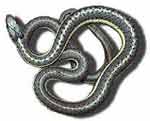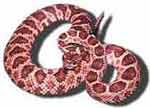Order:
Squamata
Serpentes: (Snakes)
The following taxonomic list will link you to the individual species.
Snakes have several unique characteristics that should allow you to readily
identify them as members of the group Serpentes. All snakes lack limbs;
there are however, some species that have vestigial![]() limbs in the form of small spurs. All snakes lack eyelids (there are some
lizard species that lack eyelids, but none in Idaho). Snakes have no external
ear opening (some burrowing lizards lack ear openings as well, but all Idaho
lizard species have an external ear opening). Finally, snakes have a elongate
body. Again, there are some lizard species that are limbless and have
long slender bodies, but none of these species occur in Idaho.
limbs in the form of small spurs. All snakes lack eyelids (there are some
lizard species that lack eyelids, but none in Idaho). Snakes have no external
ear opening (some burrowing lizards lack ear openings as well, but all Idaho
lizard species have an external ear opening). Finally, snakes have a elongate
body. Again, there are some lizard species that are limbless and have
long slender bodies, but none of these species occur in Idaho.
Family: Boidae
|
The family Boidae
includes the largest living snakes, but the Idaho representative of
this family, the Rubber Boa (Charina bottae) is very modest
in size. The 20 genera (Pough et al. 1998) that comprise this
family occupy a wide range of habitats and come in a wide range of
forms. There is also variety in the reproductive modes of species
within this family. The pythons (subfamily Pythoninae) are oviparous |

|
Family: Colubridae
| The family Colubridae
is the largest snake family, containing approximately 70 percent of all
snake species (Pough et al. 1998). This wide range of diversity makes
it difficult to describe any family characteristics that hold true for all
members of the family. Members of this family are found worldwide,
they vary in reproductive mode, having both oviparous |
||
 |
 |
 |
| Coluber
constrictor (Racer) |
Diadophis
punctatus (Ringneck Snake) |
Hypsiglena
torquata (Night Snake) |
 |
 |
 |
| Masticophis
taeniatus (Striped Whipsnake) |
Pituophis
catenifer (Gopher Snake) |
Rhinocheilus
lecontei (Longnose Snake) |
 |
 |
 |
| Sonora
semiannulata (Ground Snake) |
Thamnophis
elegans (Western Terrestrial Garter Snake) |
Thamnophis
sirtalis (Common Garter Snake) |
|
The family Viperidae contains venomous species ranging from the readily recognizable rattlesnakes to the vipers of the old world. The envenomation mechanism of members of this family are at the highest form of development (Goin and Goin 1971). The fangs are hollow and connected to venom glands to allow the injection of venom when biting. When the mouth is closed, the long fangs are folded up towards the roof of the mouth. When Vipers strike, their fangs swing foward to puncture the target and allow envenomation. The family contains 20-27 genera that are distributed across North, Central and South America, eastern Asia, Africa, and Eurasia (Pough et al. 1998). The Idaho representative of this family is the Western Rattlesnake (Crotalus viridis). |

|